Crisis
Who is involved in manual scavenging?


See The Situation in your district
0000000
Dry Laterines
0000000
Sewer Cleaning
0000000
Railway Cleaning
0000000
Deaths Reported
Questions for you
1. Are open defecation and manual scavenging the same?
No, open defecation is the passing of stools in the open while manual scavenging is people cleaning someone else’s shit from homes or elsewhere.
2. Where does your shit go?
Your shit goes into sewers. Manual scavengers are employed to clean these shitty sewers.
3. How many deaths occur in sewage line cleaning yearly?
Reports say nearly 2,000 manual scavengers die every year in the sewers, due to exposure to poisonous gases. If we include deaths that occur in septic tanks, then the number would be even higher.
4. What is the lifespan of manual scavengers?
Only 40-45 years, due to multiple health issues – hepatitis, cholera, meningitis, typhoid, cardio-vascular problems, etc.
5. Why is it that only some among the poor clean others’ shit?
Because the caste system dictates that only people of certain Dalit sub-castes clean the shit of others. Those born into these castes are forced to do manual scavenging until they die.
6. How much money do you think a person earns for cleaning someone else’s shit?
Manual scavengers, predominantly women, are paid Rs 180-200 per month per household.


